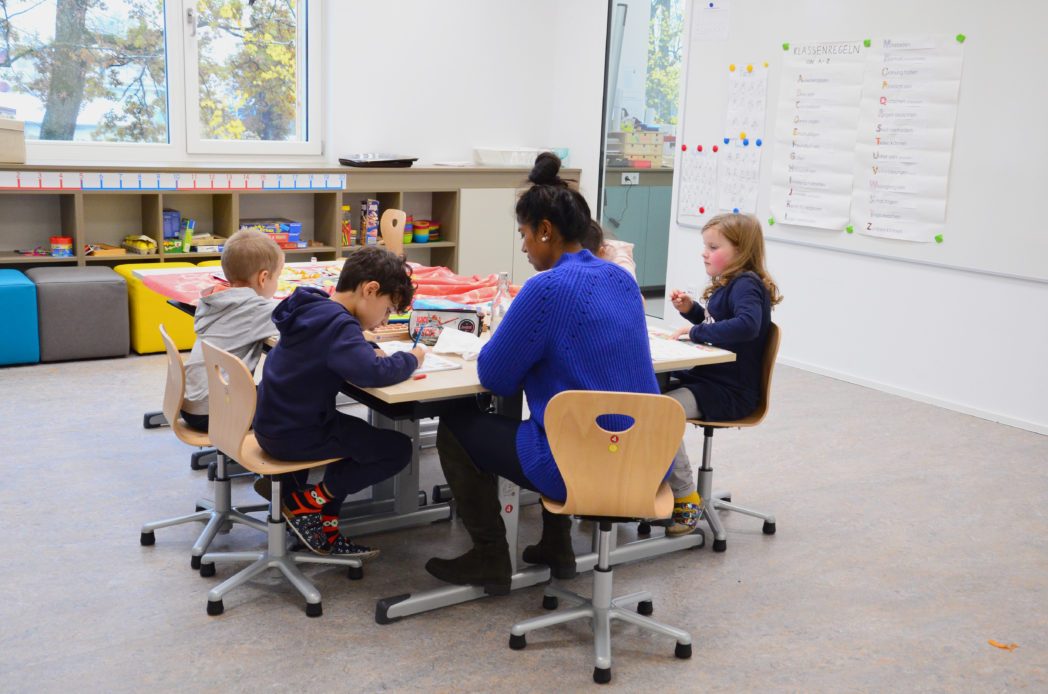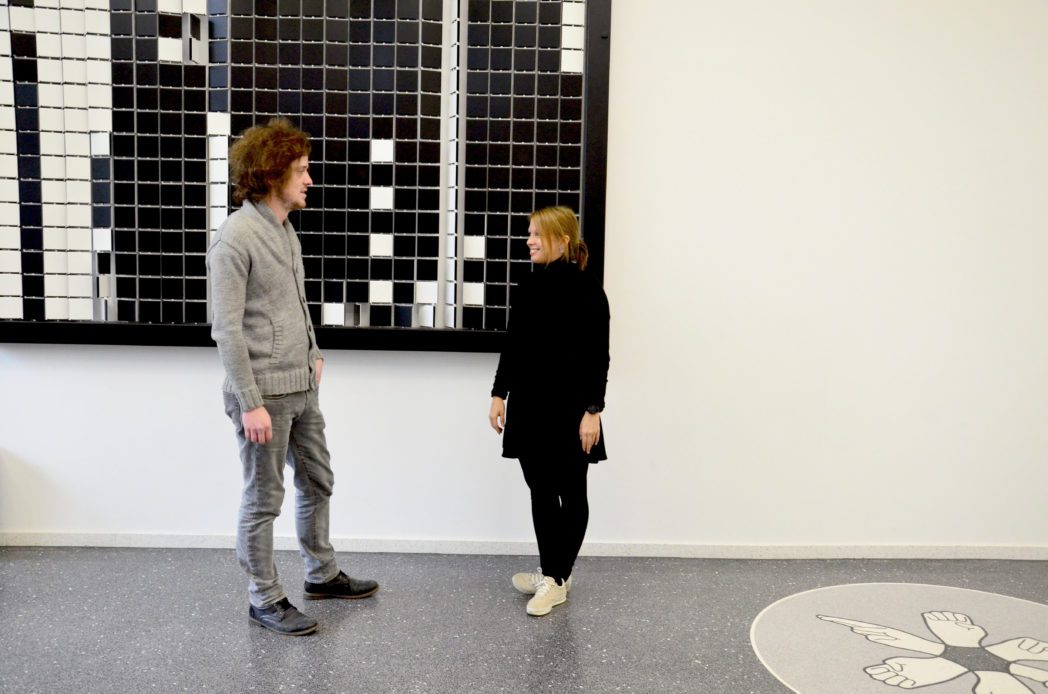
You speak of outdoors and indoors. Indoors, that’s in school, where the world is pretty much in order. Outdoors is where children often try to hide their hearing aids under their hair and themselves from prejudice. In fact, the Josef Rehrl School is different from others. This is evident not only from the unusually low noise level. As soon as you enter the modern open entrance area of the newly built school building, it becomes clear: Here, different sounds prevail.
With the construction of the Josef Rehrl School, a focus was placed on inclusion through innovation and digitalization. The project was initiated by the State of Salzburg as the client and implemented by the project partners Salzburg Wohnbau, the Salzburg architectural office kofler architects, the construction company Strabag, Salzburg AG, and the Center for Human-Computer Interaction (HCI) at the University of Salzburg. 130 students learn in partially integrative primary school, secondary school, and vocational school classes on five light-filled floors. Open encounter zones made possible by efficient sound insulation, as well as secluded classrooms and separate wardrobes for children with special needs, reflect the school’s individual approach to its subject.
Proven learning by doing
“We strive to create optimal conditions for the children so that they not only feel comfortable but also have the best learning experience,” says Stefan Fraundorfer, the school’s principal. In 1996, he first developed a concept paper “three pages long” for the pilot project for hearing-impaired and hearing students, which was approved by the state and federal governments. Since then, the school has evolved into a unique learning institution in Salzburg. In addition to auditory training, sign language lessons are mandatory for everyone, and if needed, speech therapy, occupational therapy, and psychotherapy are also offered. The interaction between the specially trained teachers and the students is highly social, “going beyond the norm and extending well into leisure time,” says Fraundorfer. The teaching staff also receives double the reward: “The students always say they are excited when the holidays are finally over.”
Resonating Floor Makes Music Tangible
In terms of software, the new school building, which opened in 2019 at a cost of €13.5 million, meets the latest standards. At the same time, it caters to the specific needs of the students: all classrooms are equipped with digital interactive whiteboard systems, sound-absorbing pinboards, and multifunctional sound hubs that can transmit sound directly to hearing aids. A section of the reading room was transformed into a professional video recording studio by the HCI team, which is available for teachers to record homework assignments for students, for example. In the gymnasium, the HCI team developed a visual and acoustic whistle in the form of a signal light, operated by a push button. The light is installed in classrooms and halls, providing a signal for breaks through sound and light.
One of the technical highlights can be found in the music room: the resonating floor. These special floor panels were designed in a collaboration between Pansound, Salzburg Wohnbau, the school management, and the HCI center. A specially developed software allows music to be experienced through vibrations in the floor. Sound is converted into vibration. In fact, an experiment conducted by the project team, composed of Alina Krischkowsky and Martin Murer from the HCI center during the initial development phase of the music room, confirmed their assumption: professional musicians were able to play together without hearing the sound. “A comparable experience is feeling a bass tone vibrating in your own body at a loud concert. We actually perceive vibrations below 250 hertz through the skin. There are already some resonating floors out there, which we didn’t invent. However, what we continuously work on is the technology behind it, to better convey the characteristics of instruments and, most importantly, tones through the signal processing software. For this, we collaborate closely with musicians, teachers, and students,” explains Murer.

Further research is being conducted
The panels on the floor can be played individually or together, connecting different instruments with the floor plates. Additionally, there is a body sound wall that functions on the same principle, but the music is perceived through the back instead of the feet. “The project is not yet complete, and we continue to work with the teachers to identify other possible forms of usage,” says Krischkowsky. The successful project is attributed to the excellent collaboration among the project partners. Roland Wernik, CEO of Salzburg Wohnbau GmbH, sees the cooperation with the Center for HCI as a great asset: “What sets HCI apart is its interdisciplinary approach, analytical methodology, and willingness to address additional specific requirements of the Rehrl School during the research project. The result is an educational institution that can serve as a role model for similar establishments in Austria well into the future.”
Artistic Representation of School Community
Returning to the entrance hall, the Center for HCI team has devised a unique meeting zone. By combining three technical-artistic elements, they create a school-related puzzle that changes daily through computer control. A video message of a person communicating in sign language moves along a long digital display. The sequence smoothly transitions across the board, requiring constant readjustment to follow it. There’s a specific reason for this: “We observed that hearing and deaf children in class continuously adjust to each other. This makes sense when reading lips and signs. It was truly eye-opening for us, a real ‘aha’ moment, this observation,” says Murer. Additionally, four hidden audio tracks are located, waiting to be discovered. Special headphones are available for those without hearing aids to trace the sounds. The third installation component is a large wall element made up of black and white rotating tiles that realign overnight to form a new symbol. Those who embark on this unique scavenger hunt and combine all three clues will uncover the current theme. The entrance area thus reflects the entire school – the harmonious coexistence, the interaction between hearing and deaf individuals, and the exchange that takes place.
That might also interest you
6. March 2025
salz21: Necessary Steps for the Future
On March 5, 2025, salz21 | Home of Innovation once again provided a platform for future topics, innovations, and interdisciplinary exchange. More than 1,000 visitors took the opportunity to learn about current developments and discuss perspectives for tomorrow. Three topics were particularly dominant: climate protection, artificial intelligence, and a strong Europe.
12. August 2024
SBS: One Software for Many Self-Service Devices
As a leading provider of banking software in Salzburg, SBS is now exploring new markets. The company remains true to its core segment by offering manufacturer-neutral software for self-service devices in additional sectors.
30. July 2024
Meissl: Updating Established Structures
There is a great deal of know-how, technology, and experience in umbrellas—especially those built by Meissl. With the support of funding, the company has also made significant progress in the digitalization process.
29. July 2024
AI and Creativity in Focus: Highlights from the Media Summit 2024
At the traditional event of the media and creative industry, 220 people gathered at the end of July. In the prestigious Schloss Leopoldskron, the high-profile panels of the main program discussed topics such as AI, creativity, incentive funding, and algorithms in streaming TV.